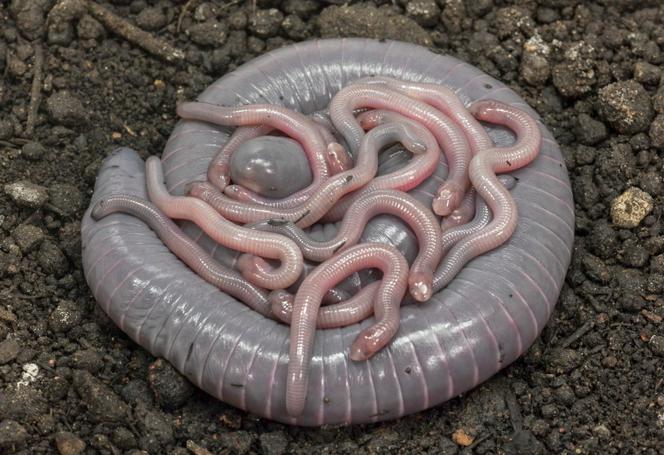


It's a creature that deserves to be better known, as it has many surprises in store. First, its anatomy. It looks like a lead-colored rubber hose, 40 to 50 centimeters long, with pale pink rings. Another one of those – large – segmented worms that frolic in soils or seas, you might think. But it's not. This animal is a vertebrate: Each of its rings corresponds to one of its vertebrae. What's more, it's an amphibian, an animal class known for the frogs, toads, salamanders, and newts... but not for ringed caecilian, those strange creatures that, under the guise of a worm or snake, display transparent skin and anatomical structures typical of amphibians.
The species of interest here is the ringed siphonops (Siphonops annulatus). Like most ringed caecilians, this animal thrives in the tropics of South America, particularly Brazil, and lives exclusively underground. Like most of them, "it has become almost blind and has lost its legs, as an adaptation to its burrowing lifestyle," said Anthony Herrel, from the Paris National Natural History Museum.
Its locomotion is also a curiosity "unique among vertebrates," said the researcher. Thanks to its serpentine, highly mucous body, it moves fluidly through the tunnels it digs. "You get the impression that it's diving into the ground. Its sensory tentacles come into play, assessing the physical and chemical characteristics of its environment," said Carlos Jared, a biologist at the Butantan Institute in Sao Paulo, Brazil. It actually moves thanks to variations in the internal pressure of its muscles.
But the care provided by the mothers of this strange amphibian is what amazed researchers. While the females lay eggs (this is an oviparous species, like most ringed caecilians), they can also feed their young with the milk they secrete at the cloaca level, reveals Carlos Jared's team in the March 8 issue of Science. "It's mind-blowing!" said Herrel, yet well-versed in the oddities of the living.
In fact, the bug has developed two incredible adaptations to feed its young. The first alerted researchers when they observed this striking metamorphosis: The mothers, who keep their babies snuggled up close to them, change color during parental care. From lead blue (like the males), they change to a milky tone. This is because their skin fills with lipid droplets associated with proteins. Using their temporary teeth, the larvae scrape off this layer of skin, which they devour in seven minutes. They then wait three to seven days for the maternal skin to regenerate. This unexpected food source, however, is not enough to explain their rapid growth: Their weight more than doubles in the first week after hatching.
You have 21.38% of this article left to read. The rest is for subscribers only.
